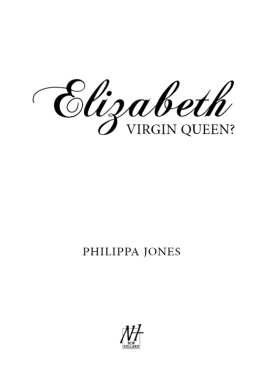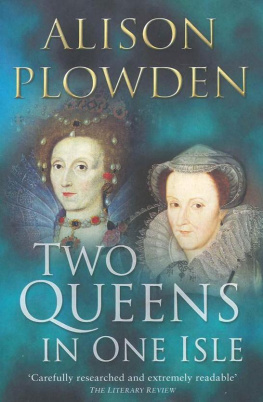

IT HAS BEEN my greatest pleasure to continue working with Michael OMara Books, and I am extremely grateful for the enthusiasm and support that I have received from the whole team. Once again, my simply amazing editor Fiona Slater has to take a great deal of the credit: her insights and dedication have been invaluable, and she has always been unwaveringly supportive. I would also like to thank Becky McCarthy and Alara Delfosse for all of their hard work.
Thanks are also due to my agent, Andrew Lownie. The staff at the British Library, National Archives, Kent History and Library Centre, and the Institute of Historical Research have all been wonderful and exceedingly helpful. Especial thanks go to Viscount De LIsle, for allowing me to access the Kenilworth Game Book and include my research in the book. I would also like to thank the guides at Longleat and St Marys Church, Warwick, who were extremely helpful and patient when answering my endless questions. Similarly, I am very grateful to the staff and volunteers at Greys Court, and my most particular thanks go to Lynn Holmes and Gill Overy. Lynn generously gave up her time to share her meticulous research on the Knollys family with me, while Gill kindly arranged for me to access the Knollys Chapel in St Nicholass Church, Rotherfield Greys.
Thanks are due to Elizabeth Norton for her insights into the Blount family, and Estelle Paranque, who thoughtfully took the time to read the unedited manuscript and make helpful suggestions. I am also very grateful to my PhD supervisors, Ellie Woodacre and James Ross, for allowing me to take time out from my thesis to finish the book on time. A huge thank you has to go to Tracy Borman, whose work has been so inspiring to me, and who read the manuscript at such short notice. I am also grateful for the continued support of Alison Weir, Sarah Gristwood and Chris Warwick.
Writing this book has meant months of hibernation, and throughout this time I am extremely fortunate to have had the understanding and encouragement of my friends and family. Thank you so much to Sian Cossins, Ed Gulliford, Kate, Chris, Chloe and Paige Bundy, Chloe Paxton, Hollie Markham, Kerrie Britten, Keita Weston, Gwenda and Colin Peters.
I would also like to say a special thank you to two little stars, Charlie and Olivia, who have brought so much happiness into my life. Thank you for patiently putting up with me when Ive been unable to play, and for all of your love and enthusiasm. If I could offer you one piece of advice it would be to follow your dreams and never give up, and I will always encourage you both to do so.
As always, my parents have been marvellously supportive. Thanks to my dad, for reading parts of the book for me and restoring my faith in my writing ability. My mum, Sylvia, has constantly boosted my confidence and refused to allow me to give up when Ive felt like I couldnt do it. She has been my inspiration, and there could not be a more worthy dedicatee for the book.
Lastly but by no means least, I would like to say a heartfelt thank you to my wonderful partner, Matthew Peters, who has stuck by me and Lettice unswervingly. Thank you for everything, but particularly for all of your very wise words of encouragement, without which I dont think Id have been able to put pen to paper. Thank you for believing in me, and most of all, thank you for being you: you are simply the best.
ALSO BY NICOLA TALLIS
Crown of Blood

Gervase Cliftons epitaph next to Lettices tomb in St Marys Church, Warwick:
Upon the death of the excellent and pious Lady Lettice, Countess of Leicester, who died upon Christmas Day in the morning, 1634
Look into this vault and search it well,
Much treasure in it lately fell;
We all are robbed, and all do say
Our wealth was carried this away.
And that the theft might near be found
Tis buried closely under ground:
Yet if you gently stir the mould,
There all our loss you may behold:
There you may see that face, that hand,
Which once was the fairest in the land.
She that in her younger years,
Matched with two great English peers.
She that did supply the wars
With thunder, and the court with stars.
She that in her youth had been,
Darling to the maiden Queen;
Till she was content to quit
Her favour, for her favourite.
Whose gold thread, when she saw spun,
And the death of her brave son,
Thought it safest to retire
From all care and vain desire,
To a private country cell
Where she spent her days so well,
That to her the better sort
Came as to an Holy Court.
And the poor that lived near
Death nor famine could not fear.
Whilst she lived, she lived thus,
Till that God, displeased with us,
Suffered her at last to fall,
Not from him, but from us all.
And because she took delight
Christs poor members to invite,
He fully now requites her love,
And sends his angels from above,
That did to Heaven her soul convey
To solemnise his own birth day.

MANY OF THE places that Lettice once knew have long since vanished, including most of the sumptuous royal palaces of Tudor England. Both Leicester House and Wanstead, her main homes during the time of her marriage to the Earl of Leicester, are no longer extant. The buildings that do survive, however, were the scenes of some of the most poignant and significant moments of Lettices life.
Greys Court, Oxfordshire
It was at Greys Court that Lettices life began, and where she passed the majority of her childhood. The interior of the house has largely altered since Lettices day, but she would have recognized much of the exterior and outer fabric. Similarly, the church of St Nicholas in the heart of the nearby village of Rotherfield Greys is now primarily the work of a later era. The most significant reminder of Lettice and her family, though, is the magnificent tomb effigy of her parents, flanked by fifteen of their children. Lettice is clearly distinguishable among them, although whether she ever saw this splendid memorial to her parents is unknown.
Chartley, Staffordshire
The manor house at Chartley where Lettice spent much of her marriage to Walter Devereux no longer survives, but the ruins of the crumbling castle of Chartley can be seen nearby. The church at Stowe, which may have been where at least one of her children were christened, also contains the tomb effigy of Walter Devereux, the grandfather of her first husband.
Kenilworth Castle, Warwickshire
Although the mighty castle of Kenilworth now lies in ruins, enough survives to convey the former glory that would have greeted Lettice and her contemporaries as they enjoyed their hunting parties and summer holidays. More significantly, it is still possible to get a flavour of the grandeur that would have been experienced by Queen Elizabeth and her court as they arrived for the Princely Pleasures in 1575. With this in mind, the spectacular Elizabethan Garden at Kenilworth has since been recreated, while Leicesters Gatehouse can also still be visited. Built in the 1570s, it was intended to provide a grand entrance to the castle before being turned into a private house in the following century. The elaborate alabaster fireplace, proudly displaying Leicesters initials, is housed inside, and once stood in the rooms used by Elizabeth I.
Next page









